
Starting June 1st, 2023 Our warehouse fee will be $0.65/cubic foot per month
In effort to lower the warehouse storage fee during inflation, we have went narrow aisle racking.This construction took us four months but the project is finally completed. With narrow aisle racking, we are able to drop storage by 24%.We as partners will go through this inflation together.
08/04/2024
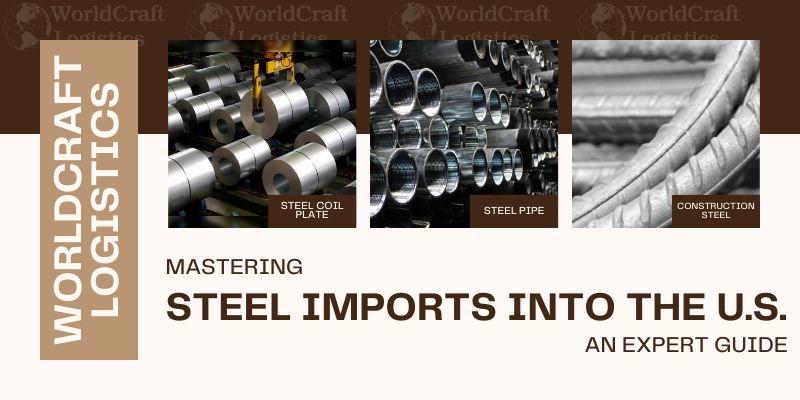
Importing steel will require you to take into account a lot of different considerations. The charges that must be paid and the requirements that must be fulfilled are covered in our guide. Because of the high domestic demand for steel, importers into the United States now operate a large industry. When determining how to import steel into the United States, there are several aspects you should be aware of. Finding out where to import your steel from, how much import duties will cost, and the license requirements are all crucial information.
The U.S. is the world's largest buyer of steel products, averaging nearly 28 million metric tons annually over the past few years. Despite peaking at 141 million tons of domestic production in 1969, the U.S. has since reduced its output. Small specialty and mini-mills have replaced many of the large mills, creating a necessity for importing steel.
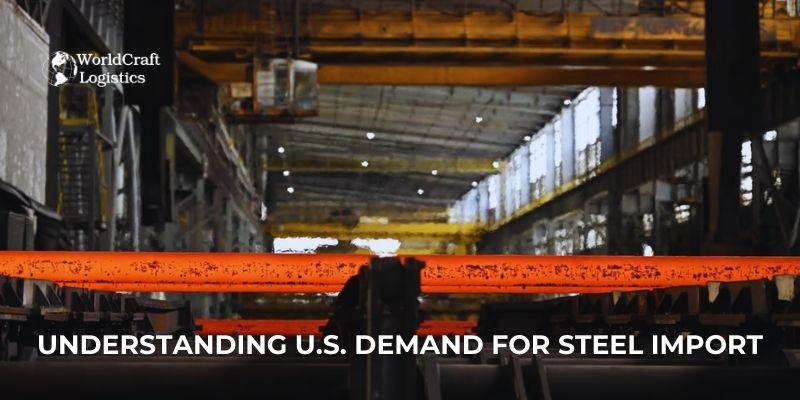
Despite China not being in the top 10 sources of U.S. steel imports, it still exported over 430 thousand metric tons to the U.S. in 2021.
However, steel imports from China face a 25% tariff under Section 232 and Section 301 regulations. Section 301 specifically targets fabricated structural steel, which is exempt from Section 232.
Moreover, many steel imports from China are also subject to anti-dumping and countervailing duties (AD/CVD), imposing additional taxes. Businesses sourcing steel from China must ensure they have the financial capacity to cover these extra costs.
To learn about the special features of shipping services from China to the US, the benefits and how shipping costs change, please see the following article: 👉 Shipping from China to USA
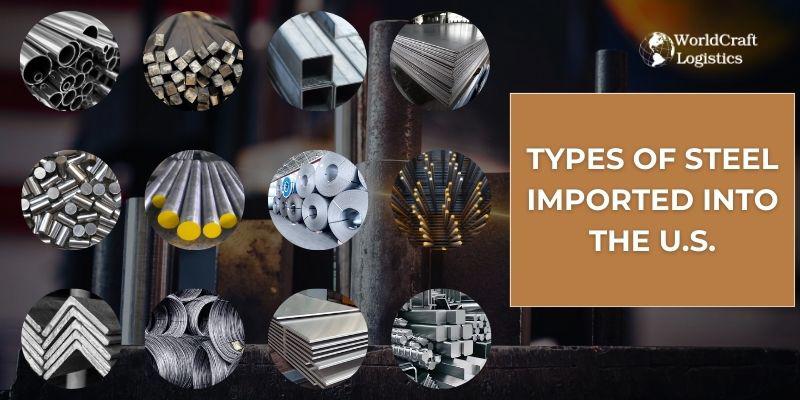
In 2024, the United States saw a varied import profile for steel products, with several types of steel experiencing notable trends. According to data from the American Iron and Steel Institute (AISI), the total steel import permit applications for the first five months of the year reached approximately 12.96 million net tons (NT), marking a 6.1% increase from the same period in 2023. Finished steel imports during this period were about 9.88 million NT, reflecting a 4.4% increase year-over-year.
Key steel products imported into the U.S. include:
Galvanized Steel: This type saw significant growth, with imports rising by 39.9% year-over-year, totaling 1.3 million tons in the first half of 2024. Galvanized steel is commonly used in construction and automotive industries due to its corrosion-resistant properties (Global Steel Web).
Cold Rolled Sheets: Imports of cold rolled sheets increased by 38% year-to-date, which are crucial for manufacturing appliances, automobiles, and construction materials.
Wire Rods: Imports grew by 30%, used extensively in construction, automotive, and various manufacturing processes.
Sheets and Strip (Hot Dipped Galvanized and Other Metallic Coated): These products saw a 42% and 70% increase, respectively, indicating robust demand in sectors requiring high-strength, corrosion-resistant materials.
Primary suppliers of steel to the U.S. in 2024 include Canada, Brazil, and Mexico. In the first five months, Canada was the top supplier with 2.84 million NT, despite a 6% decrease compared to the previous year. Brazil and Mexico followed, supplying 2.04 million NT and 1.71 million NT respectively.
Overall, the diversity in types of steel imported into the U.S. reflects the varying needs of its industrial sectors, from automotive and construction to manufacturing and infrastructure development.
Importing scrap metal can be lucrative but challenging. Compliance with U.S. Customs and Border Protection (CBP) regulations and quality standards is essential. Key steps include:
Researching U.S. import regulations
Identifying reliable suppliers
Verifying quality and HTS classification
Obtaining necessary licenses and permits
Preparing documentation
Arranging logistics and shipping
Ensuring customs clearance
Steel is a crucial material in various industries, from construction to manufacturing. Shipping steel efficiently and safely is vital due to its weight and susceptibility to corrosion. Steel is usually shipped by boat, train, or truck, depending on its origin, destination, and form. Here are some common methods of steel shipment:
️🎯 Method: Steel products, such as coils, sheets, and pipes, are loaded into standard shipping containers.
️🎯 Benefits: Provides protection from the elements and theft, and allows for easy loading and unloading using standard equipment.
️🎯 Common Uses: Small to medium-sized steel products.
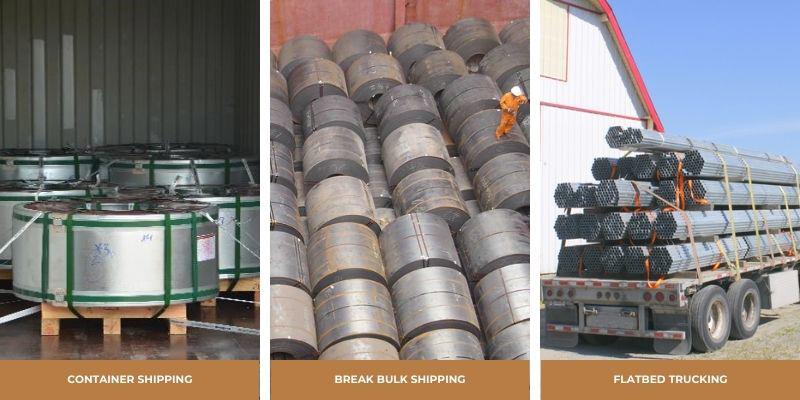
️🎯 Method: Steel is transported in large quantities without packaging, often in specialized bulk carriers or cargo holds.
️🎯 Benefits: Economical for large volumes of steel, reduces packaging costs.
️🎯 Common Uses: Large quantities of raw or semi-finished steel, such as billets, slabs, or coils.
️🎯 Method: Steel products are transported as individual pieces rather than in containers.
️🎯 Benefits: Suitable for oversized or irregularly shaped steel items that do not fit into standard containers.
️🎯 Common Uses: Large machinery parts, construction beams, and other large steel structures.
️🎯 Method: Steel products are loaded onto flatbed trucks for transport by road.
️🎯 Benefits: Flexible and can handle a variety of steel shapes and sizes, including oversized loads.
️🎯 Common Uses: Short to medium distances, construction sites, and manufacturing plants.
️🎯 Method: Steel is loaded onto specialized rail cars designed for heavy and bulky goods.
️🎯 Benefits: Economical for long distances, high load capacity, and reduced road congestion.
️🎯 Common Uses: Transport between steel mills, distribution centers, and major industrial hubs.
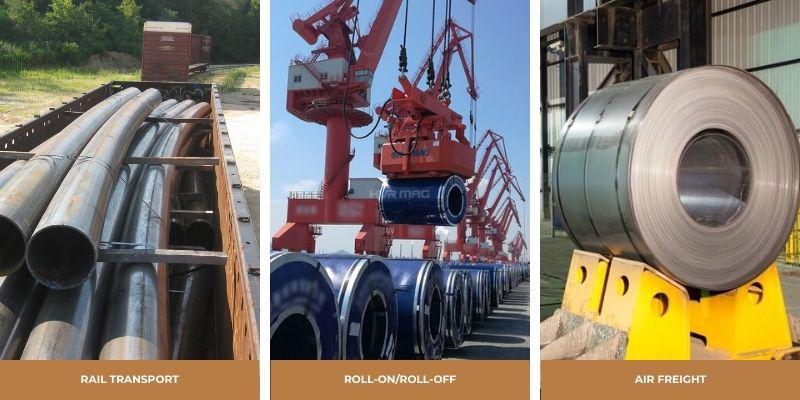
️🎯 Method: Steel is transported via inland waterways on barges.
️🎯 Benefits: Cost-effective for heavy and bulky loads, reduces highway congestion.
️🎯 Common Uses: Transport along rivers and canals, especially in regions with extensive waterway networks.
️🎯 Method: Steel products are transported using Ro-Ro ships, where items are driven on and off the vessel.
️🎯 Benefits: Efficient for steel products mounted on wheeled transport, minimizes handling damage.
️🎯 Common Uses: Steel products that can be transported on trailers or vehicles.
️🎯 Method: Steel products are transported by air.
️🎯 Benefits: Fastest method, suitable for urgent shipments or high-value steel products.
️🎯 Common Uses: Small, high-value steel components, or when time is a critical factor.
*Handling and Packaging Considerations
Corrosion Protection: Use of rust inhibitors, coatings, and protective packaging to prevent corrosion during transit.
Securement: Proper strapping, bracing, and blocking to prevent movement and damage.
Documentation: Accurate documentation and labeling to ensure smooth customs clearance and handling.
Choosing the appropriate method of steel shipment depends on factors such as the type and quantity of steel, distance, cost, and time constraints. Each method has its advantages, and selecting the right one ensures that steel products are delivered safely and efficiently.
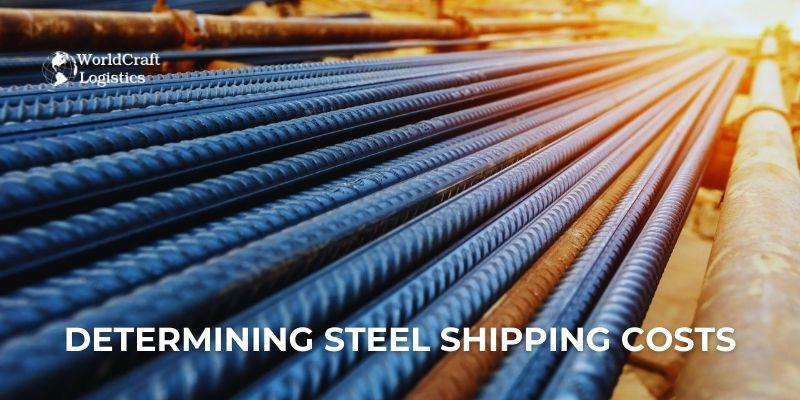
Steel’s weight significantly influences its shipping costs. Weighing 489 pounds per cubic foot, steel is over 25 times heavier than wood. Shipping costs are calculated based on weight, size, shipping method, and time frame, with heavier materials like steel incurring higher costs.
Understanding these factors and planning accordingly ensures safe, efficient, and cost-effective steel transportation, essential for supporting construction and manufacturing industries globally.
The Steel Import Monitoring and Analysis (SIMA) office issues licenses for all steel product imports into the U.S. Importers can apply for licenses online through the SIMA Licensing System. For shipments valued at $5,000 or less, a “low value” license may be obtained.
Section 232 Tariffs | Section 232 imposes a 25% tariff on steel and a 10% tariff on aluminum from most trade partners. However, exceptions exist for Canada, Mexico, Brazil, South Korea, Argentina, Japan, and the United Kingdom. Note that these tariffs do not apply to fabricated structural steel variants. |
Section 301 Tariffs | Section 301 targets products from China, affecting over $550 million worth of goods, including a 25% tariff on fabricated structural steel. Importers may be eligible for refunds if previously paid Section 301 duties on steel imports. |
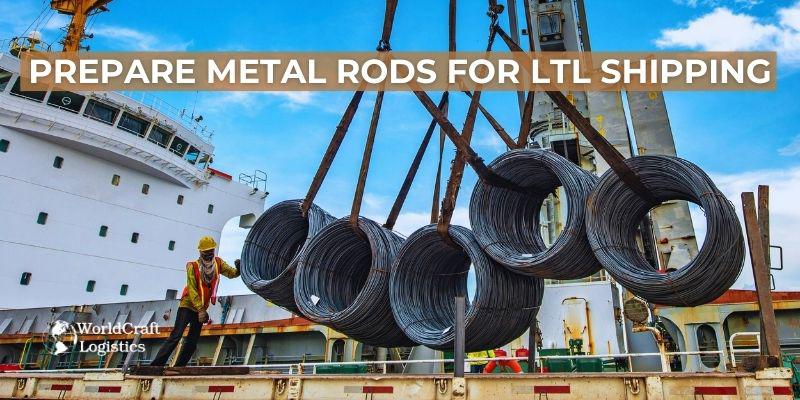
Shipping metal rods via Less-Than-Truckload (LTL) requires careful preparation to ensure their safe and efficient transportation. Here are the steps to prepare metal rods for LTL shipping:
Measure the length and diameter of the metal rods to determine the appropriate packaging and shipping requirements. Calculate the total weight of the shipment to ensure it complies with LTL carrier regulations.
Bundle metal rods of similar sizes together to prevent damage and facilitate handling. Secure the bundles with steel or plastic banding. Ensure the banding is tight enough to hold the rods together but not so tight that it causes damage.
Wrap each bundle with protective materials such as plastic wrap, foam, or cardboard to prevent scratches and corrosion. Use plastic or rubber end caps on the rods to protect the ends from damage and reduce the risk of injury during handling.
Select sturdy pallets or crates that can support the weight and dimensions of the bundled rods. Place the bundled rods on the pallet or inside the crate. Secure them with additional banding or straps to prevent movement during transit.
Add cushioning materials, such as foam or cardboard, between the bundles and the pallet or crate to absorb shocks and vibrations.
Label each pallet or crate with the appropriate shipping labels, including the destination address, handling instructions, and any required barcodes. Prepare the necessary shipping documents, including the Bill of Lading (BOL), packing list, and any required customs paperwork for international shipments.
Use forklifts or pallet jacks to load the pallets or crates onto the LTL truck. Ensure the equipment is suitable for handling the weight and size of the shipment. Use load bars, straps, or ropes to secure the pallets or crates inside the truck to prevent shifting during transit.
Coordinate with the LTL carrier to schedule a pickup time that aligns with your shipping timeline. Communicate any special handling instructions to the carrier to ensure the safe and efficient transport of the metal rods.
*Additional Tips
By following these steps, you can optimize the safety and integrity of your metal rod shipment for LTL transportation. Proactive bundling, strategic blocking, and meticulous securing minimize the risk of damage and streamline the shipping process, contributing to overall efficiency and cost savings. Prioritizing these measures demonstrates a commitment to responsible cargo handling and maximizes the benefits of LTL shipping for your business.
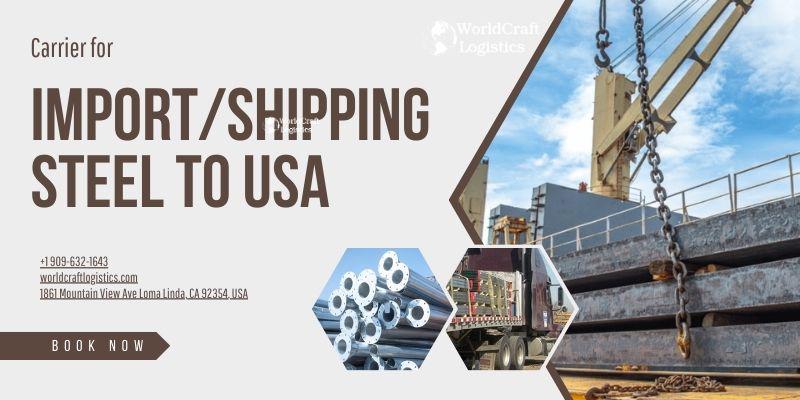
When you need full truckload service, particularly for shipping long metal rods or large quantities, choosing the right carrier is crucial. WorldCraft Logistics connects clients with suitable carriers for their specific shipment needs. Leveraging our extensive network of freight trucking companies nationwide, we ensure access to a diverse range of haulers. Whether you need a flatbed, RGN, or step deck for transporting metal rods, our expertise lies in efficiently matching clients with the appropriate specialty vehicles.
Our commitment extends beyond mere connectivity. We excel at locating and booking specialty vehicles tailored to unique cargo requirements. If your shipment demands specialized handling or equipment, such as those needed for metal rod transportation, our truckload shipping experts are here to help.
Contact us at (909) 632-1643 to tap into our specialized knowledge base, or use our user-friendly online quote tool for truckloads to start the process seamlessly. Check out our best-in-class services:
👉 How to Shipping Hazardous Materials & All you need to note
👉 Reputable Shipping Car Parts Internationally Service
👉 Import Fruits and Vegetables into the US
Whether you need to navigate the complexities of shipping oversized cargo or ensure the secure transportation of large quantities, WorldCraft Logistics is ready to meet your shipping needs.
With a customer-centric approach and a wealth of industry experience, we streamline the carrier selection process, allowing you to focus on your core business objectives while entrusting your shipment to capable hands.
SEO
Digital Marketing/SEO Specialist
Simon Mang is an SEO and Digital Marketing expert at Wordcraft Logistics. With many years of experience in the field of digital marketing, he has shaped and built strategies to effectively promote Wordcraft Logistics' online presence. With a deep understanding of the logistics industry, I have shared more than 500 specialized articles on many different topics.
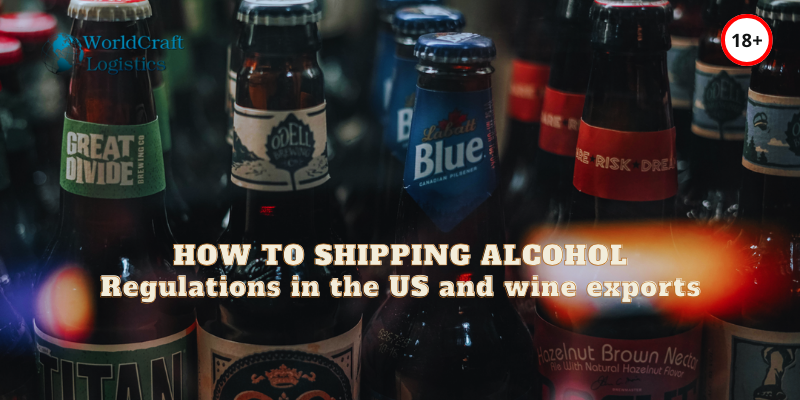
Shipping
12/21/2023
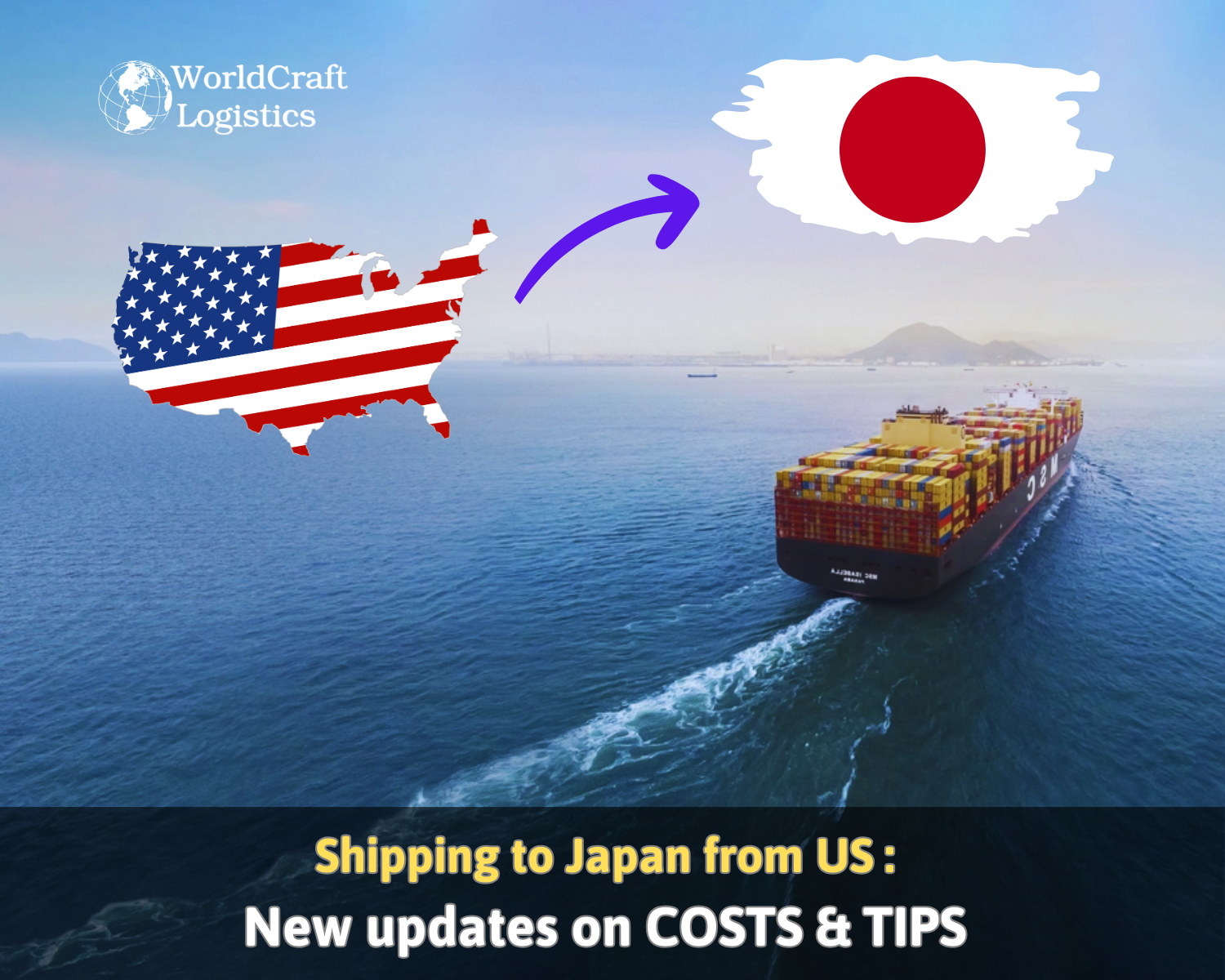
Shipping
02/28/2024
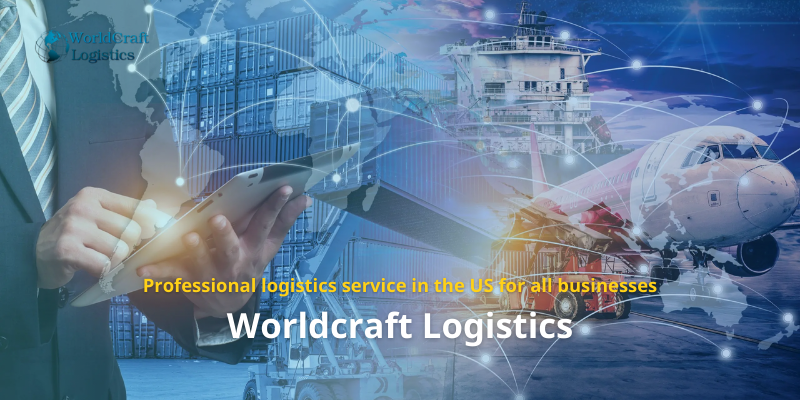
Shipping
12/24/2023
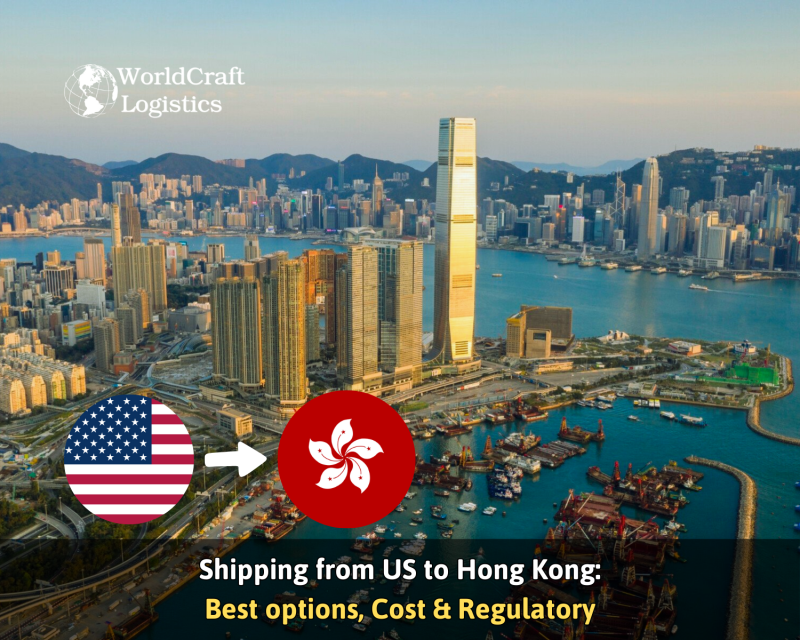
Shipping
04/02/2024
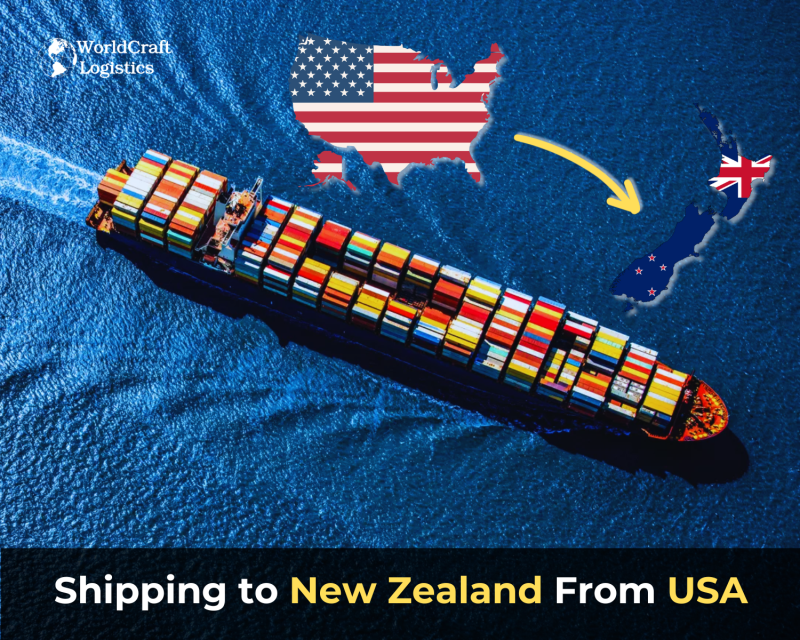
Shipping
11/04/2024